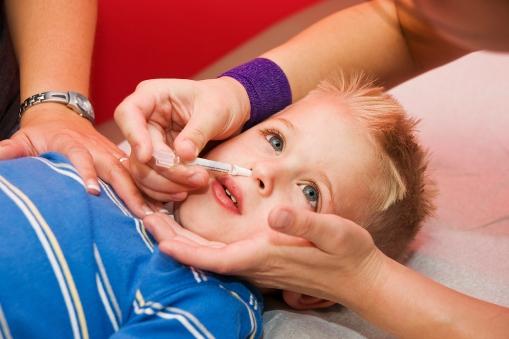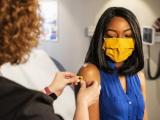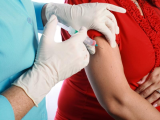Two studies published last week by Centers for Disease Control and Prevention (CDC) and other researchers noted that the live attenuated influenza vaccine—a nasal spray option—failed to adequately protect kids from the 2009 H1N1 strain in 2013-14, when it was the predominant circulating strain.
The maker of the vaccine, MedImmune, has already changed the 2009 H1N1 strain in its LAIV vaccine, FluMist, in hopes it will fix the problem, CDC researchers involved in both studies told CIDRAP News. They noted that reporting of these data before their publication, in 2014, enabled MedImmune to act in time to change this year's vaccine.
One of the new studies, in Pediatrics, compared LAIV with the inactivated influenza vaccine (IIV, or flu shot) over three seasons after the 2009-10 pandemic. The other looked solely at 2013-14 and included adults. It appeared in the Journal of Infectious Diseases.
The studies involved essentially the same group of researchers, who drilled down into US Influenza Vaccine Effectiveness (Flu VE) Network data.
Nasal spray vs flu shot
In the LAIV-IIV comparison in Pediatrics, the investigators analyzed Flu VE Network data on children 2 to 17 years old during four seasons from 2010-11 through 2013-14. In this observational study, the researchers calculated the odds of testing either influenza-positive or influenza-negative among 2,703 kids.
Of the total, 637 received LAIV and 2,066 received IIV during the four seasons. Over all four seasons, they found no statistical difference in rates of influenza among those vaccinated with LAIV versus IIV for two of the three strains: H3N2 and influenza B.
The odds of contracting the 2009 H1N1 strain of flu, however, were three times higher in the LAIV recipients over all seasons, a statistically significant difference. And in 2013-14, a year in which 2009 H1N1 predominated, overall protection against all three strains was more than five times lower in children 2 to 8 years old—compared with three times lower in all children.
The authors of the study wrote that randomized controlled trials before the 2009-10 pandemic showed LAIV to offer superior protection to IIV in the 2-to-8 age-group, but since the pandemic, there has been a lack of consistent evidence to show superiority of LAIV in those younger kids. Which is why early last year the US Advisory Committee on Immunization Practices (ACIP) revoked its preferential recommendation for LAIV in that group for this flu season.
No H1N1 protection in kids in 2013-14
The study that looked solely at the H1N1-dominated 2013-14 season included Flu VE Network data on 5,637 kids and adults 6 months and older who had medically attended acute respiratory illness.
The researchers determined that overall flu vaccine effectiveness (VE) against medically attended 2009 H1N1 was 54%, with influenza being confirmed by polymerase chain reaction. For IIV, it ranged from 54% to 75%, depending on age-group, and 63% in children 8 years and younger and 61% in older kids and teens.
The VE for LAIV in children, however, was a statistically insignificant 17%, given that the 95% confidence interval dipped into negative territory. Too few adults received LAIV to determine a meaningful VE for them.
The authors noted that the results have been corroborated not only by the Pediatrics study but by another observational test-negative design study sponsored by MedImmune and published Nov 14 in Vaccine.
Findings tied to vaccine component?
In both studies the authors proffer several explanations for the findings of low to no H1N1 protection of LAIV in kids. Foremost among them is that properties of the vaccine strain itself might have affected fitness or stability of the virus.
"An amino acid sequence was identified in the HA [hemagglutinin] stalk region of wild-type A/California/7/2009 H1N1pdm09 virus that reduced thermal stability of the LAIV vaccine virus containing the A/H1N1pdm09 HA gene," they wrote. "This stalk sequence resulted in lower virus infectivity in ferrets and greater susceptibility to degradation at high temperatures."
The CDC's Brendan Flannery, PhD, MPH, said that no one hypothesis likely provides a complete explanation for his group's findings, but he also emphasized the makeup of the H1N1 vaccine virus. "I think it's related to the structure of the H1N1 vaccine construct," he told CIDRAP News.
"We are hopeful that the update of the vaccine construct [by MedImmune] is going to make LAIV more effective against pandemic H1N1 viruses."
Flannery is an epidemiologist in the CDC's Influenza Division and lead investigator with the Flu VE Network.
Another hypothesis offered in an accompanying Journal of Infectious Diseases commentary by infectious disease specialist Andrew Pavia, MD, of the University of Utah, is that of immune-mediated limitation of replication in 2009 H1N1 viruses.
He said that, because the H1N1 virus in 2013-14 had circulated with little antigenic change and the H1N1 vaccine component was unchanged since 2009, it is possible that immune mechanisms limited replication of LAIV in recipients, lessening the immune response. He said this phenomenon has been hypothesized to explain why LAIV is less effective than IIV in older adults.
Flannery, however, downplayed this hypothesis for a number of reasons, including the fact that no decreased VE was observed in the other two circulating strains that season, H3N2 and flu B.
Findings shaped federal recommendations
Flannery and Jessie Chung, MPH, a Flu VE Network data manager, noted that their group's initial findings of LAIV shortcomings were presented at an ACIP meeting in October 2014 and in part led to the group's February 2015 decision to drop its preference for LAIV in younger children.
The Pediatrics study was done at the request of the ACIP, with the researchers fine-tuning the study design to put the low-VE H1N1 into a more longitudinal context, Flannery said. He added that it's difficult to evaluate LAIV effectiveness across seasons because a high LAIV uptake is needed to produce meaningful data.
See also:
Jan 6 Pediatrics study
Jan 6 J Infect Dis study
Jan 6 J Infect Dis commentary
Feb 26, 2015, CIDRAP News story "ACIP drops preference for nasal-spray flu vaccine in kids"
Nov 18, 2015, CIDRAP News scan on Vaccine study





















